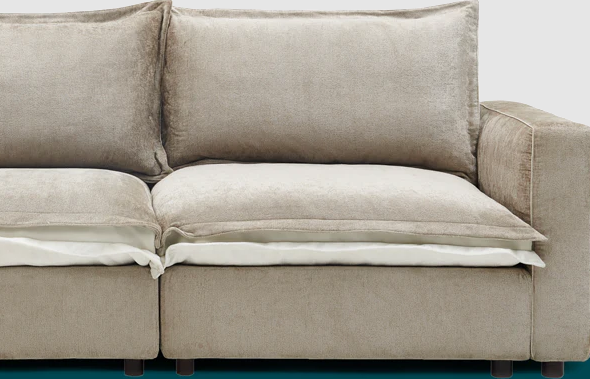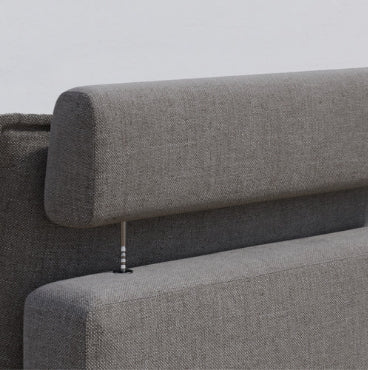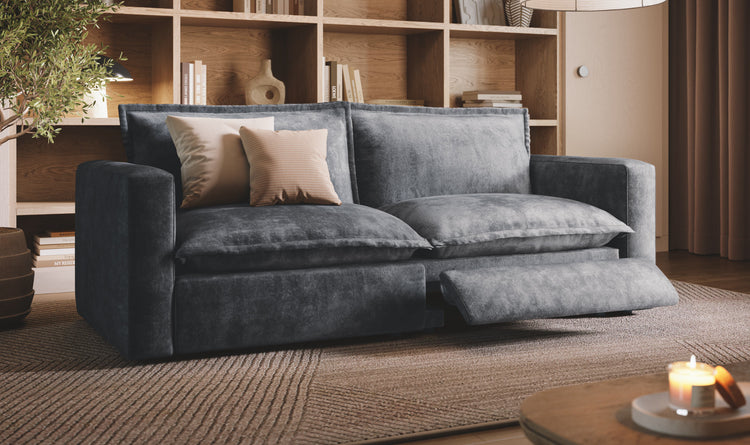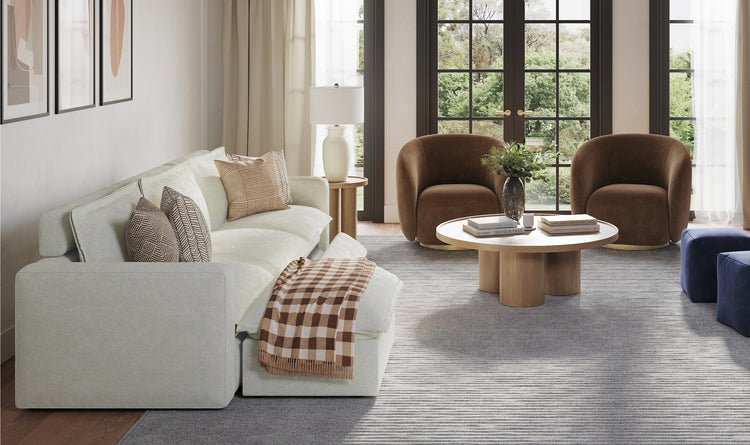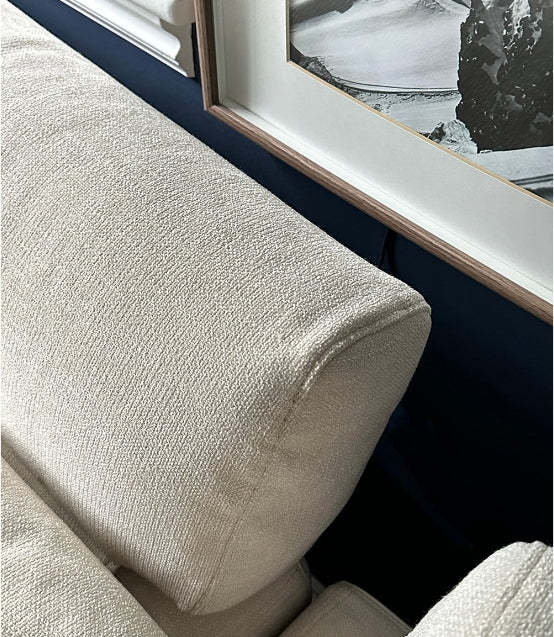When your favorite spot on the sofa begins to sag, it can really spoil the comfort of your home. It's a common problem with sofas as they age or get plenty of use - the cushions just don't hold up like they used to. But there's no need to worry about buying a new couch just yet. This article is here to help you fix those droopy cushions and get your sofa back in shape. We'll guide you through easy-to-follow steps that will firm up your seating and make your sofa look as good as new.
At Homebody, our sofas are made tough, with layers of high-quality materials in the cushions to reduce sagging and keep their shape over time. But like all well-loved pieces of furniture, a bit of settling is natural as the years go by. If you start to notice less bounce when you sit down, don't worry. Reach out to us-our customer service team is ready with advice and assistance to revitalize those cushion layers, so your sofa feels as cozy and welcoming as the day you first brought it home.

Why Do Sofa Cushions Start to Sag?
Worn Out with Time
Just like a well-loved pair of shoes, the materials in your sofa cushions break down over the years. The foam gets compressed, and the fibers within can lose their springiness. This is just natural wear-and-tear - it happens to all sofas over time, no matter how sturdy they were when you first bought them.
The Support Factor
Not all cushion supports are made equal. Some sofas have high-quality, resilient foams that take longer to sag, while others might start drooping sooner due to less durable materials. The type of support inside your cushion plays a big role in how long it'll stay plump and comfortable.
Sit and Repeat
Think about how often - and how - you use your sofa. Is it the main seating for family movie nights, or is it reserved for guests? Do people tend to sit in the same spot every time, creating more wear in certain areas? The more a cushion is used, and the heavier the use, the quicker it's likely to sag.
Keep It Up to Keep It Plump
Maintenance, or the lack thereof, can also lead to sagging cushions. Fluffing pillows, rotating cushions, and occasional deep cleans help maintain shape and longevity but are often overlooked tasks. Ignoring these simple care steps can speed up the sagging process.

What Checks Should You Make Before Fixing Saggy Cushions?
- Check for Sagging Spots: Give your sofa a thorough once-over to see where it dips and sags. It could be one cushion or a group of them needing attention.
- Wear Pattern Assessment: Don't just eyeball the saggy bits - check every cushion for wear. It might not be obvious at first glance, but these little things can impact how comfy your sofa feels and looks over time.
- Support Structure Evaluation: Peek under those cushions and investigate the webbing or mesh support. If it's looking stretched out or damaged, this could be a part of the problem.
- Cushion Squeeze Test: Press down on your cushions. If they're not springing back, or if they're too easy to squish, the insides might be giving up.
- Listen for the Crunch: When you compress the cushions, stay quiet and listen. If it sounds like you’re stepping on fallen leaves, the stuffing inside may be on its way out.
- Sit and Feel Around: Take a seat and shuffle around. If you find a spot that dips more than the rest, it's a sign of uneven wear that needs fixing.
- Frame Inspection for Stability: Run your hands along the frame – push and prod to make sure it doesn’t budge or groan under pressure. Any movement or noise could mean repair work is in order before you tackle the cushions.
- Look for Frame Damage: Check the sofa’s skeleton for any signs of damage, such as cracks or rusty spots. These flaws can affect how solid your sofa feels and might need fixing first.
- Test the Springs: If your sofa has springs, press down to feel for any that are sticking out or not bouncing back like they should. Uneven spring tension can be really uncomfortable to sit on.
- Check the Sofa's Level: Place a level on the base of the sofa to ensure everything is even. If it's off-kilter, you'll want to sort that out before you do anything else.
- Fabric Wear and Tear Check: Survey the upholstery closely. If there are tears or places where it’s stretched thin, you’ll want to mend these alongside refreshing your cushions.
- Sniff Test for Mustiness: Trust your nose – if your cushions smell like a damp basement, it could signal mold or mildew lurking inside, which means some extra cleanup is needed.

What Will You Need to Fix Those Cushions?
Got a case of the droopy couch blues? No worries, plumping up those saggy sofa cushions is easier than you think! Here's what you'll need to get your couch looking cozy and inviting again:
-
Foam Inserts or Batting: Depending on how firm you want your cushions, grab some high-density foam for a solid fix or poly-fil batting for a softer touch.
-
A Seam Ripper: This little tool will be super handy to gently open the seams where you'll insert the new padding.
-
Fabric Scissors: Get these ready for trimming your foam or batting to the perfect size.
-
Upholstery Thread: Stronger than regular sewing thread, this will ensure your handiwork holds up well.
-
Curved Upholstery Needle: A curved needle makes stitching through thick cushion fabric way easier.
-
Measuring Tape: You'll need this to measure your cushions so that you buy the right amount of foam or batting.
-
Marker or Chalk: Use this to outline the cut lines on your foam, making sure your new inserts are the perfect fit.
-
Zip Ties: These are great for cinching together multiple layers of foam if you're going for extra height.
-
Plywood: If your sofa frame needs extra support, cut a thin piece of plywood to fit the base under the cushions and it will work wonders.
With these tools at the ready, you'll be all set to give your sofa a well-needed makeover that'll bring back the comfort and look you love.
How to Get Those Cushions Firm and Fabulous Again
Fresh Foam for a Bouncy Seat
Give your cushions a new lease on life by adding or replacing the foam inserts. Here's the scoop on how to do it:
-
Cutting to Size: Measure your cushion covers from seam to seam, then buy high-density foam that matches these dimensions. You'll want to cut the foam about a half-inch bigger than your measurements for a snug fit. Use an electric carving knife or a sharp utility knife for clean cuts.
-
Inserting and Securing: Once your foam is cut, it's time to tuck it into the cushion cover. It might be a tight squeeze, but that's good – it means no lumps or bumps. If the cover has a zip, close it carefully; if not, you may need to stitch the opening shut. For added security, you can wrap the foam with a layer of batting before inserting it into the cover.
Plumping Up with Batting or Filler
If your cushions are feeling deflated, more stuffing can make all the difference:
-
Opening the Case: Carefully open the cushion cover or use the existing zipper. If you have to cut it open, try to do so along the seam for an easier sew-up job later.
-
Stuffing Evenly: Spread the batting or down filler evenly across the cushion, paying extra attention to corners and edges, which tend to get less love. The goal is to fill it up enough to eliminate sag but not so full that it feels like sitting on a balloon.
-
Closing It Up: Once you're happy with the fluff factor, sew the cushion back up or zip it closed. Take care to make strong stitches that will hold everything in place.
Base Reinforcement for Ultimate Support
If the cushions aren't the only issue, you might need to firm up the foundation with some plywood or webbing:
-
Measure Twice, Cut Once: Get the exact size of your sofa seat area and cut a piece of plywood to fit. Sand the edges to prevent any snags or tears on your cushions.
-
Positioning the Plywood: Slide the plywood beneath the cushions. It should lie flat and not bulge upward. Fasten it with screws if necessary, but often its own weight is enough to keep it in place.
-
Feeling the Firmness: Test it out! Sit down and feel the difference. If it's too firm, you can add a thin layer of foam or batting on top of the plywood. If it's still sagging, check if you need to adjust or add more support.
With these steps, you're well on your way to turning that saggy couch into the best seat in the house once again.

How Can You Prevent Cushions from Sagging in the Future?
Rotate and Flip Regularly
Keep your cushions from getting too cozy in one position. Make it a habit to rotate and flip them regularly - this means swapping them from one side of the sofa to the other and turning them over. This way, they wear more evenly, and no single cushion takes all the pressure.
Mindful Seating Matters
Treat your sofa like the trusty companion it is. Avoid the temptation to plop down hard or let the kids use it as a trampoline. Gentle sitting helps maintain the integrity of the cushion's inner workings and keeps sag at bay.
Spread the Weight
If you have a favorite spot, try to mix it up sometimes. Sitting in different places on the sofa ensures that no one area is bearing all the weight all the time. Encourage an even distribution by inviting guests or family members to switch spots now and then - your cushions will thank you for the balanced use.
Keep Your Sofa from Sagging
No need to worry about a saggy sofa anymore. With the simple fixes we've talked about, you can make your couch as comfy as it was on day one. Just remember, a bit of cushion care-like flipping and gentle sitting-can keep them in shape for longer. Now, go enjoy that like-new lounge spot. It's all set for your next chill session or big family hangout.
